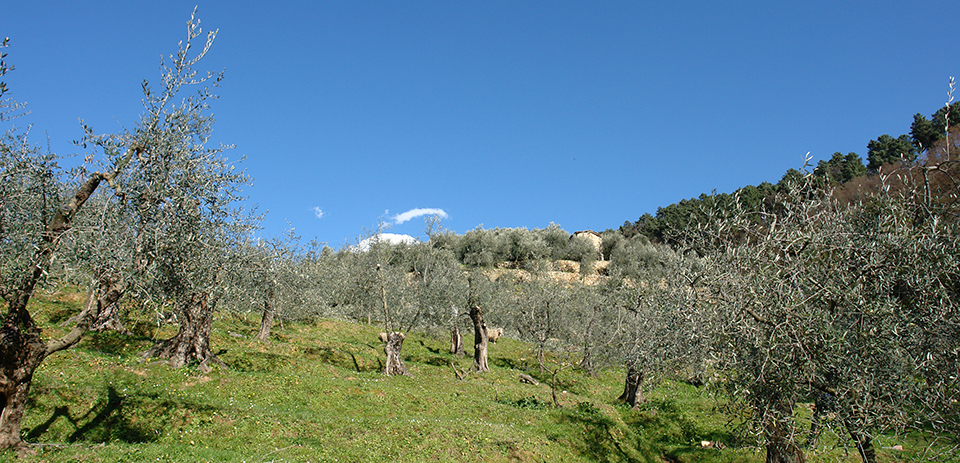
PRODUCTION
Our olive grove is lovingly tended and nurtured all year long by our team and external experts, so that a harmonic interaction between man and nature can be guaranteed at all times. We are members of the professional farmers registry of the Lucca province (registration number 1241/Sez. 2).
Pruning
The annual growth cycle of the olive tree begins with pruning at the end of February. The main purpose of pruning is to ensure the quality of the oil. The olive tree is by its nature a shrub, and would it not be pruned immediately after planting, it would soon grow out of control and turn into an unmanageable bush. The not pruned shrub would give a higher yield, but manual harvesting would be impossible, and we would end up with olives that have fallen to the ground or into the nets by themselves because they are too ripe. Such olives would never turn into a high-quality oil, which can only be obtained from olives picked at the right stage of ripening and pressed a few hours after picking!
Fertilization
Olive trees can survive for thousands of years under difficult conditions, but if they are to be used to make oil they need to be treated, protected and nurtured. Out of respect we support and strengthen our plants and the soil exclusively with natural products.
From March to September we feed plants and soil in a 20 to 30 day rhythm with a complex mixture of minerals, trace elements, micro-organisms, plant extracts and essential oils which work on a homoeopathic basis. The products manufactured by the companies Biplantol and Mack bio-agrar increase vitality and the plants become more tolerant to stress. The symbiosis between plant and soil organisms is encouraged so that the plants can develop under optimal conditions.
In addition we feed our olive trees after the harvest with the twigs from pruning; cut up and composted they contain valuable nutrients. Cut grass is also a natural fertilizer but it is only absorbed into the soil when cut short, which obviously is very time-consuming.
Blossoming
May is the month of blossoming which must be monitored carefully. One hundred blossoms usually develop into one to three olives.
Summer months
The summer months are devoted to monitoring the biggest enemy of the olive tree, the olive fly, as well as to the continuous mowing of the terraced hills. Monitoring devices and hormone-based traps are placed all over the olive grove in order to keep track of the presence of male and female flies.
As a safe-guard against the fly we spray our trees in a 20 day rhythm with powdered porcelain clay. The 'white' olive orchard confuses the flies so that they don't see the olives. In the event that some still end up on the olives the kaolin dust acts as a guard against the entry of the eggs.
Harvesting
Harvesting starts at the beginning of October and is mostly concluded at the end of October. We work with a team of about 10 people which are divided into people who spread the nets, shakers and gatherers. We use a harvesting device called "Manina" which means "little hand", to gently shake the branches. Its two air supplying devices help to blow even the most stubborn olives off their stems. It should be pointed out that olives that fall into the nets by themselves must not be used because the ripening enzyme is already too far advanced.
In these busy times the harvest is daily transported in airy containers to the olive mill. We gather approximately 800 kg of olives a day corresponding to about 110 l of oil (the yield is calculated as a percentage kg of olives / kg of oil: 1kg of olives = 1,092 l - 1 l of olive oil = 0,916 kg)
Oil mill
We have developed a business relationship with a very modern oil mill which guarantees the immediate processing. Today the individual steps are washing, crushing, grinding, pressing (i.e. separating oil through decanting/centrifugation) and filtering are performed by steel machines. A computer monitors the whole process to make sure the temperature never exceeds 28° C.
Additionally we have agreed with our oil mill that prior to every pressing process the mill is stopped and given a thorough cleaning. This guarantees that no remainder of the predecessor's oil will be mixed with ours and also that the temperature is lowered by several degrees.
Storing
Before being bottled, our oil is poured into steel containers and stored in the cellar of Il Casone at a temperature between 13°C and 15°C, under vacuum, in a nitrogen-based environment and in total darkness.
Since the oil should reach the customer in perfect condition we exclusively bottle the oil only when ordered.







